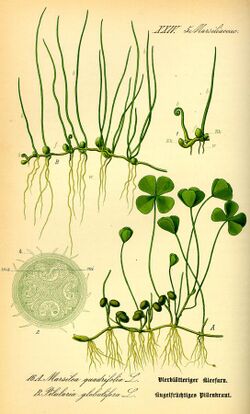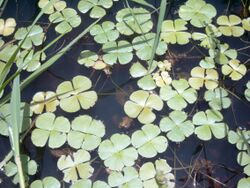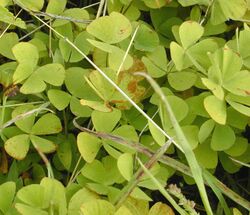Biology:Marsileaceae
| Marsileaceae | |
|---|---|

| |
| Pilularia (top) and Marsilea (bottom) | |
| Scientific classification | |
| Kingdom: | Plantae |
| Clade: | Tracheophytes |
| Division: | Polypodiophyta |
| Class: | Polypodiopsida |
| Order: | Salviniales |
| Family: | Marsileaceae Mirb. |
| Genera | |
| |
Marsileaceae (/mɑːrˌsɪliˈeɪsi.iː/) is a small family of heterosporous aquatic and semi-aquatic ferns, though at first sight they do not physically resemble other ferns. The group is commonly known as the "pepperwort family" or as the "water-clover family" because the leaves of the genus Marsilea superficially resemble the leaves of a four-leaf clover. In all, the family contains 3 genera and 50 to 80 species with most of those belonging to Marsilea.[1][2]
Natural history
Members of the Marsileaceae are aquatic or semi-aquatic. Plants often grow in dense clumps in mud along the shores of ponds or streams, or they may grow submerged in shallow water with some of the leaves extending to float on the water surface. They grow in seasonally wet habitats, but survive the winter or dry season by losing their leaves and producing hard, desiccation-resistant reproductive structures.[3]

There are only three living genera in the family Marsileaceae. The majority of species (about 45 to 70) belong to the genus Marsilea, which grows worldwide in warm-temperate and tropical regions.[1][2] Marsilea can be distinguished from the other two genera by the presence of four leaflets on each leaf, although some species occasionally produce six leaflets per leaf. A second genus Regnellidium includes a single living species that grows only in southern Brazil [3] and neighboring parts of Argentina ;[2] it has only two leaflets per leaf. The third genus Pilularia grows widely in temperate regions of both the northern and southern hemispheres.[3] Its leaves do not subdivide into leaflets but are slender and tapered to a point, so that it is often overlooked and mistaken for a grass. There are only about five species known.[2]
The closest relatives of the Marsileaceae are the Salviniaceae, which are also aquatic and heterosporous.[4][5] However, both of these other fern families float freely on the surface of ponds or lakes instead of rooting in soil or mud. The close relationship of these groups to the Marsileaceae is supported by both morphologic and molecular analysis,[4] as well as by the discovery of an intermediate fossil named Hydropteris.[6] In general, the Salviniaceae and Azollaceae have a much better fossil record than the Marsileaceae.[7] Until recently, Rodeites dakshinii was the oldest fossil member known; it is a preserved sporocarp containing spores, found in Tertiary chert of India .[7] In 2000, the discovery of fossilized sporocarps from the Cretaceous of eastern North America was announced.[8] These fossils were assigned to the species Regnellidium upatoiensis, and pushed the known history of the Marsileaceae back into the Mesozoic. Other remains include Regnellites nagashimae from the Upper Jurassic or Lower Cretaceous of Japan .[9] The fossils include leaves with visible veins, as well as sporocarps. The currently oldest known member of the family is Flabellariopteris, described in 2014 from isolated leaves dating to the Late Triassic in Liaoning, China.[10]
Morphology
The Marsileaceae share many of the basic structural characteristics common to most ferns, but the differences are more noticeable than the similarities. Species of this family have long, slender rhizomes that creep along or beneath the ground. Their fronds (leaves) grow in distinct clusters at nodes along the rhizome, with wide spacing between leaf clusters. As a result, the plants appear to be more stem than leaf, unlike other ferns.
Roots grow primarily from the same nodes as the leaves, but may also grow from other locations along the rhizome. The roots of Marsilea and Regnellidium are noteworthy for containing vessel elements. Vessels have also been found in the rhizome of two species of Marsilea. These vessels have evolved independently of vessels in other groups of plants.[11]

The leaves are the most easily observed characteristic for the Marsileaceae; they have a long slender leaf stalk ending in zero, two, or four (occasionally six) leaflets. The number of leaflets differs among the three genera and can therefore be used for identification.[2] In Pilularia, the leaves are narrowly cylindrical and taper to a point. Leaves of Regnellidium bear two broad leaflets, while leaves of Marsilea bear four leaflets at the tip. The four leaflets on the leaf of Marsilea are not borne equally. Instead, they are borne in pairs with one pair of leaflets attached slightly higher than the other.[12] Thus in the developing leaf, the leaflets are folded more like the wings of a butterfly than like the leaflets of a clover.
As with other ferns, the leaves develop in a circinate pattern.[11] They begin as small, tight spirals which unroll as the leaf matures. At full maturity they are held erect with the leaflets unfolded, except in Pilularia whose leaves have no blade. Temperate species are deciduous, losing their vegetative leaves in winter.[1] Tropical species may also lose their leaves during the dry season. These leaves are photosynthetic, and produce most of the food used by the plant.
Some aquatic species of Marsilea, especially those growing with their rhizome submerged, may have vegetative leaves that are dimorphic. Some of their leaves grow up to the surface of the water, and look just like leaves of species growing out of water. These plants also produce other leaves with shorter leaf stalks that are not long enough to reach the surface, and so the leaflets remain underwater. These leaves have different anatomical and cellular characteristics better suited to their submerged environment.[11]
In addition to their vegetative (sterile) leaflets, all species of Marsileaceae produce fertile (spore-producing) leaflets at or near the base of the photosynthetic leaves. This reproductive portion looks and functions very differently from the vegetative portion of the leaves.
Life cycle
Like other ferns, members of the Marsileaceae produce spores, but not seeds when they reproduce. Unlike other ferns, the spores in this family are produced inside sporocarps. These are hairy, short-stalked, bean-shaped structures usually 3 to 8 mm in diameter[1] with a hardened outer covering. This outer covering is tough and resistant to drying out, allowing the spores inside to survive unfavorable conditions such as winter frost or summer desiccation. Despite this toughness, the sporocarps will open readily in water if conditions are favorable, and specimens have been successfully germinated after being stored for more than 130 years.[13] Each growing season, only one sporocarp typically develops per node along the rhizome near the base of the other leaf-stalks, though in some species of Marsilea there may be two or occasionally as many as twenty.[12][14] The resemblance of the sporocarps to peppercorns gives the family its common name of pepperwort.[1]

The sporocarps are functionally and developmentally modified leaflets,[14] although they have much shorter stalks than the vegetative leaflets. Inside the sporocarp, the modified leaflets bear several sori, each of which consists of several sporangia covered by a thin hood of tissue (the indusium). Each sorus includes a mix of two types of sporangium, each type producing only one of two kinds of spores. Toward the center of each sorus and developing first are the megasporangia, each of which will produce a single large female megaspore. Surrounding them at the edge of the sorus and developing later are the microsporangia, each of which will produce many small male microspores.[11]
Because the Marsileaceae produce two kinds of spore (and thus two kinds of gametophyte), they are called heterosporous. While heterospory is the norm among all plants with seeds, such as the flowering plants and conifers, it is very rare among other groups of plants. Also, most heterosporous plants produce their two kinds of sporangia in different places on the plant. Since the Marsileaceae grow both kinds together in a single cluster, they differ from other plants in this regard as well.
The spores remain dormant inside the sporocarp through unfavorable conditions, but when conditions are suitable and wet, the sporocarp will germinate. It splits into halves, allowing the tissue coiled inside to become hydrated. As this internal tissue swells with water, it pushes the halves of the hard outer covering apart, and emerges as a long gelatinous worm-like sorophore. The sorophore is a sorus-bearing structure unique to the Marsileaceae; it may extend to more than ten times the length of the sporocarp inside which it was coiled. This extension carries the numerous spore-producing sori attached along each side of the sorophore out into the water.[11][14]
Human uses
Some species of Marsilea are cultivated in garden pools or aquaria.[3] The Indigenous Australians once made a porridge of pulverized Marsilea sporocarps called nardoo. However, the sporocarps contain toxic levels of thiaminase, so careful preparation methods must be used in order for the nardoo to be safe for consumption.[13]
References
- ↑ 1.0 1.1 1.2 1.3 1.4 Johnson, David M. (1993). "Marsileaceae". Flora of North America north of Mexico (volume 2 ed.). New York & Oxford: Oxford University Press. pp. 331–335. ISBN 0-19-508242-7. http://www.efloras.org/florataxon.aspx?flora_id=1&taxon_id=10539.
- ↑ 2.0 2.1 2.2 2.3 2.4 Pryer, Kathleen M. (1999). "Phylogeny of Marsileaceous Ferns and Relationships of the Fossil Hydropteris pinnata Reconsidered". International Journal of Plant Sciences 160 (5): 931–954. doi:10.1086/314177. PMID 10506474. http://www.pryerlab.net/publication/fichier203.pdf.
- ↑ 3.0 3.1 3.2 3.3 Lellinger, David B. (1985). A Field Manual of the Ferns & Fern-Allies of the United States & Canada. Washington, D. C.: Smithsonian Institution. pp. 303–307. ISBN 0-87474-603-5. https://archive.org/details/fieldmanualoffer00lell/page/303.
- ↑ 4.0 4.1 Smith, Alan R.; Kathleen M. Pryer; Eric Schuettpelz; Petra Korall; Harald Schneider; Paul G. Wolf (2006). "A classification for extant ferns". Taxon 55 (3): 705–731. doi:10.2307/25065646. http://www.pryerlab.net/publication/fichier749.pdf.
- ↑ Kenrick, Paul; Peter R. Crane (1997). The Origin and Early Diversification of Land Plants: A Cladistic Study. Washington, D. C.: Smithsonian Institution Press. pp. 243–244. ISBN 1-56098-730-8.
- ↑ Rothwell, G. W.; R. A. Stockey (1994). "The role of Hydropteris pinnata gen. et sp. nov. in reconstructing the cladistics of heterosporous ferns". American Journal of Botany 81 (4): 479–492. doi:10.2307/2445498.
- ↑ 7.0 7.1 Taylor, Thomas N.; Edith L. Taylor (1993). The Biology and Evolution of Fossil Plants. Englewood Cliffs, NJ: Prentice Hall. pp. 434–435. ISBN 0-13-651589-4.
- ↑ Lupia, R.; H. Schneider; G. M. Moeser; K. M. Pryer; P. R. Crane (2000). "Marsileaceae Sporocarps and Spores from the Late Cretaceous of Georgia, U.S.A". International Journal of Plant Sciences 161 (6): 975–988. doi:10.1086/317567. http://www.pryerlab.net/publication/fichier200.pdf.
- ↑ Yamada, Toshihiro; Masahiro Kato (2002). "Regnellites nagashimae gen. et sp. nov., the Oldest Macrofossil of Marsileaceae, from the Upper Jurassic to Lower Cretaceous of Western Japan". International Journal of Plant Sciences 163 (5): 715–723. doi:10.1086/342036.
- ↑ Sun, Chunlin; Li, Tao; Na, Yuling; Wu, Wenhao; Li, Yunfeng; Wang, Lixia; Zhang, Lijun (July 2014). "Flabellariopteris, a new aquatic fern leaf from the Late Triassic of western Liaoning, China" (in en). Chinese Science Bulletin 59 (20): 2410–2418. doi:10.1007/s11434-014-0359-6. ISSN 1001-6538. Bibcode: 2014ChSBu..59.2410S. http://link.springer.com/10.1007/s11434-014-0359-6.
- ↑ 11.0 11.1 11.2 11.3 11.4 Gifford, Ernest M.; Adriance S. Foster (1988). Morphology and Evolution of Vascular Plants (3rd ed.). New York: W. H. Freeman and Company. pp. 305–313. ISBN 0-7167-1946-0. https://archive.org/details/morphologyevolut00giff_689.
- ↑ 12.0 12.1 Eames, Arthur J. (1936). Morphology of Vascular Plants (Lower Groups). New York and London: McGraw-Hill Book Company. pp. 197–223. ISBN 0-88275-459-9.
- ↑ 13.0 13.1 Moran, Robin C. (2004). A Natural History of Ferns. Portland: Timber Press. pp. 243–249. ISBN 0-88192-667-1.
- ↑ 14.0 14.1 14.2 Campbell, Douglas Houghton (1918). The Structure and Development of Mosses and Ferns (3rd ed.). New York: The Macmillan Company. pp. 417–439. https://archive.org/details/cu31924087302018.
External links
- Marsileacae description in the Flora of North America
- Diversity map for US species
- Lupia et al. article describing Cretaceous fossils of Marsileaceae
Wikidata ☰ Q1115420 entry
 |

